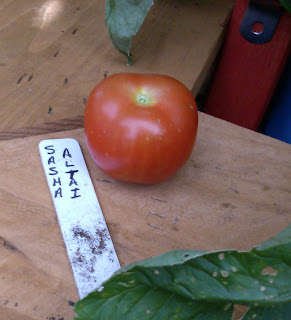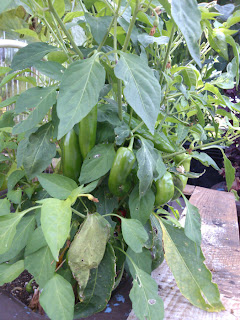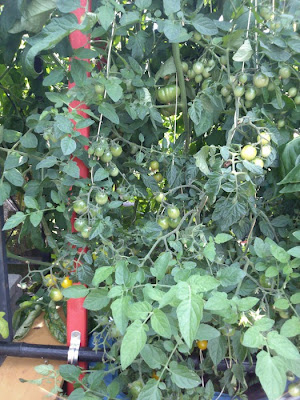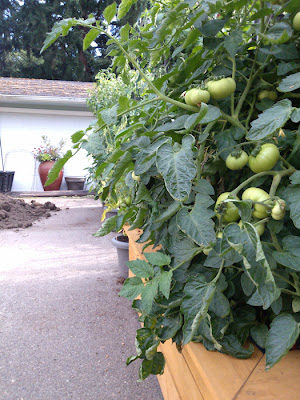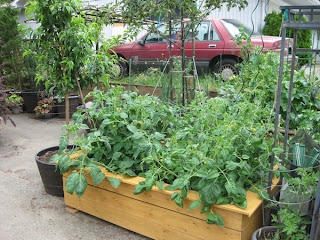 Sub-Irrigation
Planters (SIPs) are portable, self-watering containers that can be built in any
number of sizes to accommodate different vegetable types and sizes.
Sub-Irrigation
Planters (SIPs) are portable, self-watering containers that can be built in any
number of sizes to accommodate different vegetable types and sizes.
The basic
Sub-Irrigation Planter has three layers - the bottom layer is water, the middle
layer is air and the top layer is soil.
The top layer has two pockets that extend down into the water, wicking
the water up into the soil as needed.
Because plants need oxygen to their roots, you don't want the soil to
sit directly in the water. The planter
has a floor that sits above the water line, providing an air layer between the
soil and the water that provides the needed oxygenation to the roots and
prevents the plants from drowning.
You only need two
water wicking pockets to keep the plants watered appropriately.
Sub-Irrigation
Planters (SIPs) are pretty easy to do yourself.
To make your own, you will need the following items:
 1 - 30 gallon
plastic storage tote (we use sterilite because they are more rigid) $11 each
1 - 30 gallon
plastic storage tote (we use sterilite because they are more rigid) $11 each
1 - 10 foot length
of 4" flexible perforated pipe (can make 2 ½ boxes with 1 pipe) $6
1 - 1" plastic
tube (thin wall) $2
Landscape cloth
Scissors
X-acto Knife
Drill with 2 drill
bits. 7/32” and ½”
Small saw for
cutting plastic tube
Brown plastic paint
(Krylon) $4
1 cubic feet potting
soil (big bag) $7 - $12

Start with a 30 gallon storage tote. We like to use the Sterilite totes because they are more rigid. Rubbermade totes are flexible and will not hold their shape well.
Remove the lid and set it aside for now.
Measure the length of the tote across the top and inside the bottom. Our 30 gallon storage totes are about 29”tall across the top. They are also about25” long in the bottom of them.
 Using the
measurements across the inside bottom, take a pair of scissors and cut your
flexible perforated pipe into sections.
You will need to cut the following 3 pieces:
Using the
measurements across the inside bottom, take a pair of scissors and cut your
flexible perforated pipe into sections.
You will need to cut the following 3 pieces:
2 – 25” pieces (bottom inside length)
1 – 15” piece
(bottom inside length minus 10”)
Perforated pipe has
holes in it that allows the water to flow in and around the pipes. This provides support for the floor while
allowing the water to flow to all areas in the water reservoir.
After the 3 pieces
are cut, lay them in the bottom of the storage tote. It’s ok if they are a little tight.
The short piece
should be on one side and placed so there are 5” gaps on each end of the
pipe. This is where the water wicks will
be located.
Next we work on the
floor that lays on top of the perf pipe.
Set the lid on a
hard surface that you can cut on. I
usually use the ground or our old picnic table.
You are going to cut all the way through, so you will scratch the
surface below the lid.
If your lid has an
indentation in it like ours do, use that as a guideline for cutting. If not, then make a line 3" in from the
edge and cut the lid center out using a sharp X-acto knife.
I have found that it
works best to do this type of cut in two passes - one pass to score the lid and
the second pass to actually cut through the lid.
Cut all the way
around the lid so the center comes out.
Set the outer piece
aside. It will be painted and put back
on the box top later.
Keep the center
piece. We will continue to work on this piece to make the floor of the
SIP.
With a sharpie
marker, draw two 4" x 4"
square corners on one long side of the floor piece.
This is only done on one side of the floor. When you are done, there should be two
squares drawn on the floor piece.
Using an X-acto
knife, cut out the two corner pieces from the floor piece.
This will be the
pockets in the floor that create the water wick pockets.
Try out the floor in
the planter. The base should sit
directly over the perf pipe and you should be able to see directly to the
bottom of the planter where the water wick pockets are located.
Next we drill vent
holes in the floor with a ½” drill bit.
I place the floor
piece on the ground and stand on it for support, then I drill holes about 4”
apart all over the base. Its ok if this is not perfect, you are creating
airflow holes.
Next we cut the 1”
stand pipe that lets us water the planter from above. The pipe should stick up about 3” from the
top of the planter. We cut ours about
18” long.
After you’ve cut the
pipe, drill water holes in the end of the pipe using the 7/32” drill bit. This helps the water flow into the reservoir
when you are topping it off.
Place the stand pipe
in the OPPOSITE side of the box that the pockets are on. If the floor is too tight, cut a notch in the
floor to accommodate the stand pipe.
(this photo is from
our tree planters, which are larger)
At this point we add
5 holes for water overflow and air flow.
The holes and the stand pipe go on the
opposite side of the planter from the wicking pockets.
Using your sharpie
marker and the diagram below, mark the 5 holes, 3 on the bottom and 2 on the
top.
The 3 water overflow
holes should be placed 3” from the bottom of the planter.
The 2 air holes
should be 4” from the bottom of the planter.
Use your 7/32” drill
bit to drill these holes. They don’t
need to be very big to be effective.
At this point I stop
and spray paint the outside of the box, the lid, the stand pipe and the inner
top of the box with a spray paint made for plastic. Krylon makes a great dark brown one that
looks like dirt and makes your planters blend in.
Next we cut our
ground cloth and add it into the planter.
We use the kind that is about 32” wide and allows water to pass through
it, so the water wicking pockets will
work properly.
Measure out about 6’
long, and lay it in the bottom of the planter, wrapping it loosely up the
sides.
Now press your hands
into the wicking holes, making pockets with the ground cloth. Make sure the ground cloth wraps up the sides
of the wicking pockets, so the dirt does not escape into the bottom and become
mud.
This will keep the
soil separated from the water, but creates the water wick pockets that can
absorb water through the holes in the ground fabric.
The last step is to
add soil to the box and get it ready for planting. I use a potting soil in the box, but your own
soil/compost mix will also work well.
ADDING SOIL
You can fill this 30 gallon SIP box with a 2 cubic foot bag of potting soil.
Slowly fill the box
¼ full and press the soil down into the water wicking pockets. Continue filling the box to half full of soil
and then stop and lightly water the soil to activate the wicking. Put the rest of the
soil in the box and water the soil again.
A water filled SIP box is heavy - about 50 pounds or more. Its alot easier to set the box in the location you’d like it in and then water the soil well to saturate it. Focus on spraying water over the wicking pockets, so the soild is wet from above as well as from below. After the box is well watered, use the stand pipe to
fill the box until water flows out of the lower set of holes.
 PREP FOR PLANTING
PREP FOR PLANTING
I like to add a few things to the soil before I add my plants or seeds.
1. Add in a cup or two of dolamite lime. This is a powdered lime with magnesium in it. Your plants will love it. Mix it into the top 4 inches of the soil.
2. I also mix a 10-10-10
fertilizer in the top 1" layer of soil and plant with desired vegetables.
After that I plant my seeds in the box the same as I plant them in the ground or put in plants if I've started them early or bought them pre-started.
**I've been trying out a few products from Hendrikus Organics this year and they seem to be doing well with the plants. In addition to the things I do above, I also add a small handful of Humagic and Organibloom in the planting hole and place the new plant on top of it. I'll keep you posted on how well they do over the summer, but so far things are going well.
From this point the process is pretty simple. Water the boxes every day and wait for things to grow in and start producing food for you.
I keep track of how long it takes to 'top off' a box by counting while I'm filling. You can use this method to track how quickly
your plants are taking up water as they hit their growth spurts or deal with
the summer heat.
Next I'll post more information on how many of each plant you can put in this sized Sub-Irrigation Planter.










